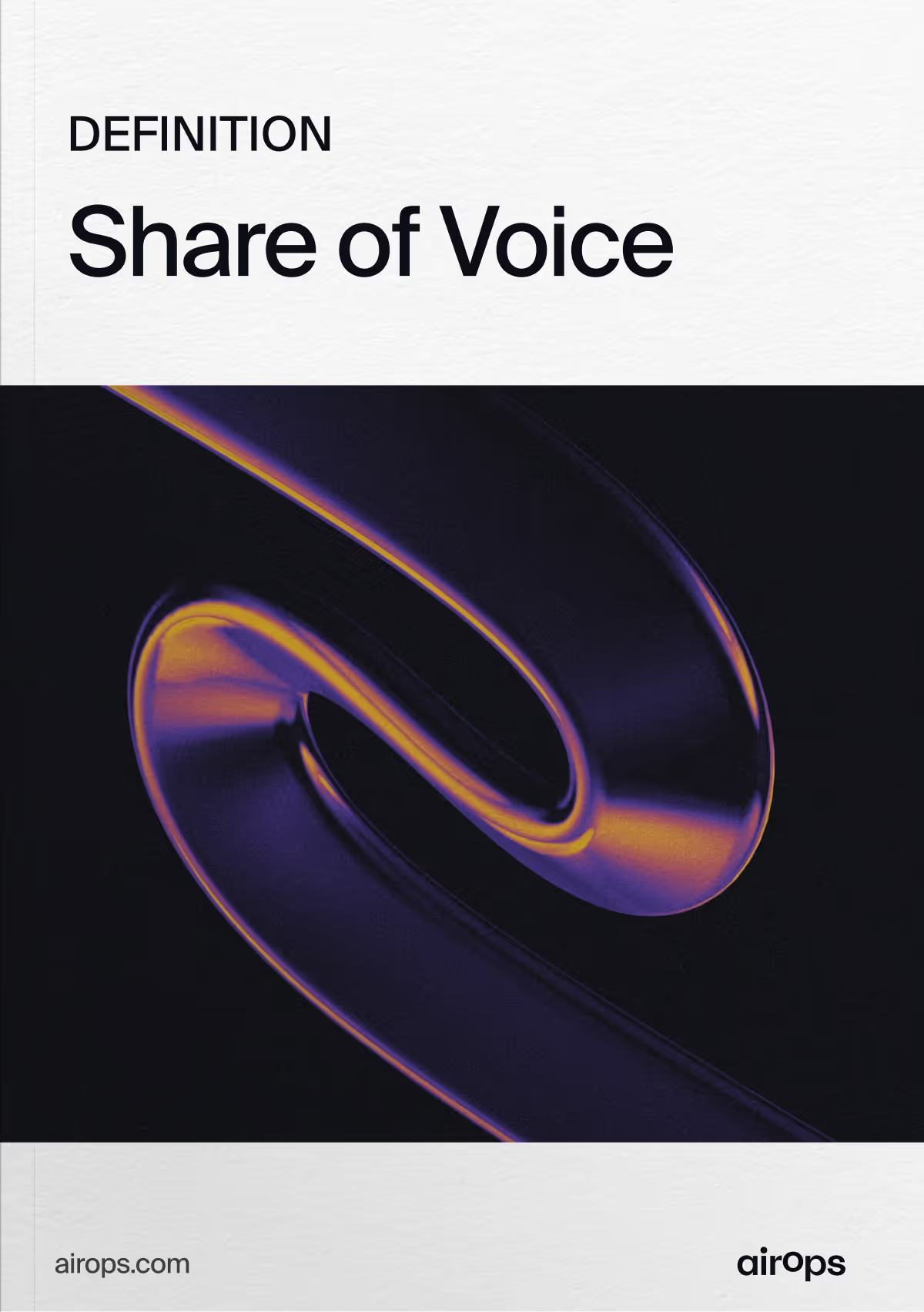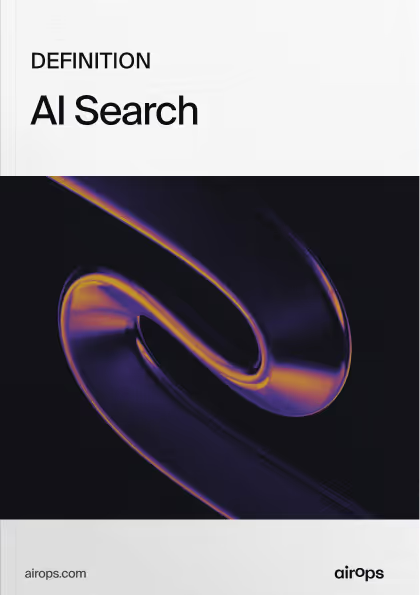What is Share of Voice?

What Is Share of Voice?
Share of voice (SOV) is the percentage of total visibility or mentions your brand earns in a market or channel compared to competitors, indicating your relative presence and authority.
Complete Definition:
Share of voice measures the portion of attention your brand captures across marketing and search channels—such as paid ads, organic search, social media, PR, and answer engines—compared to competitors. Expressed as a percentage of total mentions, impressions, or spend, it provides insight on how visible and influential your brand is within its competitive landscape.
A higher SOV often correlates with stronger brand awareness, greater authority, and potential market share growth, making it a key metric for improving discoverability in both traditional and AI search.
How Does Share of Voice Differ from Market Share?
Share of voice measures brand visibility or presence in marketing channels, while market share measures actual sales or revenue. SOV is about attention; market share is about business results.
Types of Share of Voice
Share of voice can be segmented by channel or methodology, allowing teams to benchmark performance and prioritize strategies.
The main types include:
- Paid Media SOV: Based on ad spend or impressions in digital and traditional advertising.
- Organic SOV: Reflects visibility in organic search results, often measured by keyword rankings and estimated traffic share.
- Social SOV: Tracks brand mentions, hashtags, and engagement across social platforms.
- AI SOV: Measures how frequently AI models mention or cite your brand compared to competitors in answer engines and LLM-powered platforms.
How Is Share of Voice Measured?
Share of voice can be measured across both digital and traditional channels, each offering unique insights into brand presence and competitive position. Modern tracking goes beyond advertising to include organic, earned, and AI-driven visibility.
Common measurement channels include:
- Paid media: Tracks ad impressions, spend, and placements in digital and offline advertising to calculate your brand’s share versus competitors.
- Organic search: Measures keyword rankings, SERP features, branded search queries, and estimated traffic share from search engines.
- Social media: Monitors brand mentions, hashtags, and engagement across platforms such as X, LinkedIn, and Instagram.
- Public relations (PR): Counts editorial coverage, news mentions, and third-party references in traditional and digital outlets.
- AI answer engines: Measures how often AI search platforms (e.g., ChatGPT, Gemini, Perplexity) cite, link to, or mention your brand in response to relevant queries.
According to BrightEdge Research, Google’s AI Overviews appeared for roughly 84% of queries in early U.S. rollout analysis—highlighting the importance of tracking share of voice in AI-powered results. As AI-driven search becomes a primary way people find information, brands that measure and optimize for AI share of voice can protect and grow their visibility.
How To Calculate Share of Voice
To calculate share of voice, use the following formula: Share of Voice (%) = (Your Brand’s Mentions or Visibility ÷ Total Mentions or Visibility of All Brands) × 100
Here are several methods for calculating share of voice across multiple channels:
Paid Media: Use ad impressions or spend to calculate your ad visibility relative to competitors.
Example: Your ads received 1M impressions, and total competitor impressions were 10M → SOV = 10%.
Organic Search: Measure your share of total keyword rankings or estimated traffic.
Example: Your domain ranks for 500 of the 5,000 tracked keyword impressions → SOV = 10%.
Social Media: Track mentions, hashtags, or engagement volume compared to competitors.
Example: Your brand had 2,000 mentions out of 20,000 total → SOV = 10%.
PR Coverage: Count the number of news mentions, editorial placements, or backlinks across media outlets.
AI Answer Engines (ChatGPT, Perplexity, Gemini): Measure how often AI systems cite or mention your brand compared to competitors in AI-generated answers.
Example: Your brand appears in 120 of 1,000 total AI answers within your category → AI SOV = 12%.
Why Is Share of Voice Important?
Share of voice acts as a leading indicator of brand awareness, authority, and future market share growth. By tracking SOV, marketing and SEO teams can benchmark competitive presence, spot opportunities, and prioritize efforts to improve visibility across traditional and AI search. According to research from Nielsen, brands with a share of voice higher than their market share are more likely to grow revenue over time. This growth potential is even more critical in today’s search landscape, where nearly 60% of Google searches result in zero clicks, making visibility in AI-powered results and search interfaces essential for capturing demand.
Key benefits include:
- Competitive benchmarking: Reveals how your brand stacks up against competitors in key channels.
- Brand awareness: Higher SOV signals stronger mindshare and recall among target audiences.
- AI visibility: Ensures your brand is cited and surfaced by AI agents, protecting demand capture as zero-click and AI-generated answers increase.
- Market share growth: Sustained excess SOV can predict future gains in sales and market position.
AirOps helps brands monitor and improve their share of voice across answer engines, making it easier to track visibility, identify opportunities, and increase discoverability in AI-powered search.
Why Is Share of Voice Important For Measuring AI Search Visibility?
Measuring share of voice in AI search reveals how often your brand appears in AI-generated answers compared to competitors, providing a clear benchmark for visibility in answer engines. This metric helps you identify content gaps, guide optimization efforts, and improve discoverability as AI-driven platforms increasingly shape how users find and trust information.
How Do Brand Mentions Influence Share of Voice?
Every brand mention, whether in media coverage, social posts, search results, or AI-generated answers—adds to your total visibility and can raise your share of voice. High-quality, contextually relevant mentions signal trust and authority, making your brand more likely to be surfaced in competitive channels and answer engines.
Win AI Search.
Increase brand visibility across AI search and Google with the only platform taking you from insights to action.
Table of Contents
Get the best and latest in growth and AI search delivered to your inbox each week.




